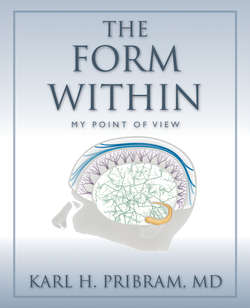Читать книгу The Form Within - Karl H Pribram - Страница 61
На сайте Литреса книга снята с продажи.
A Retinal Image?
ОглавлениеJames Gibson, renowned for his work on sensory perception at Cornell University, was adamant in his rejection of the widely accepted notion that an image of a scene is displayed on the retina by the optics of the eye, a view taken seriously by most scientists. This view suggests that the eye is like a classical camera that is constructed so that the lens sharply focuses the scene onto the film to produce a two-dimensional spatial image. The retina is conceived to be like the film in the camera. This analogy would mean that our three-dimensional perceptual experience must be constructed from this two-dimensional “retinal image.”
Gibson pointed out that this conception is faulty if only because there is constant movement in the relation between our eyes and the scene before us. His students also regarded as significant the hemispheric shape of our retina: their sophisticated view is that retinal excitation is described by cones of the Riemannian geometry of curved space, not by Euclidian points and lines. So why hasn’t their view been more generally accepted?
For me, the problem arose because, while at the University of Chicago, I had seen a retinal image, an image that appeared on the retina of the eye of an ox. Still, I felt that the Gibsonians were on to something important in placing their emphasis on (Pythagorean three-dimensional triangular) cones of light subtending degrees of arc on the retina. My discussions with Gibson did not help to solve the problem, because he insisted that all of the “information” (that is, the multidimensional patterns) was already there in the scene, and all the brain’s visual system needed to do was to “resonate” to that information. I agreed in principle but argued that we needed to know “the particular go” of how such resonances would become established. Gibson had proposed a relational, ecological approach to studying the information contained in the scene before us; I countered that we need an internal as well as an external ecology to explain the visual processing of the scene. Whenever I tried to bring brain facts into the discussion, Gibson laughed and turned off his hearing aid. I accused him of being the radical behaviorist of perception. It was all great fun, but did not resolve the issue.
